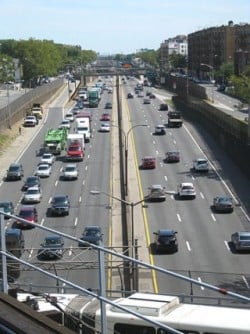“New estimates released today by the Federal Highway Administration (FHWA) show that U.S. driving topped 3.2 trillion miles last year. It is the fifth straight year of increased mileage on public roads throughout the nation, and underscores the demands facing America’s roads and bridges, and reaffirms calls for greater investment in surface transportation infrastructure,” the U.S. Department of Transportation, FHWA in the Feb. 21, 2017 “3.2 Trillion Miles Driven On U.S. Roads In 2016: New Federal Data Show Drivers Set Historic New Record” press release announced.
The D.O.T. can sure say that again!
We just learned that, according to the American Society of Civil Engineers from its “2017 Infrastructure Report Card,” that America’s infrastructure overall, received a grade of D-plus. Roads didn’t even rate that well, earning just a grade of D.

Adds the FHWA: “The new data, published in FHWA’s latest ‘Traffic Volume Trends’ report – a monthly estimate of U.S. road travel – show that more than 263.6 billion miles were driven in December 2016 alone, which is a .5 percent increase over the previous December.”
And check out this eye-opening revelation. “At 33.9 billion VMT [vehicle miles traveled], California accounted for more miles driven in December 2016 than the combined 33.8 billion miles of 22 states – Alaska, Arkansas, Connecticut, Delaware, Hawaii, Idaho, Iowa, Kansas, Maine, Mississippi, Montana, Nebraska, Nevada, New Hampshire, New Mexico, North Dakota, Rhode Island, South Dakota, Utah, Vermont, West Virginia, Wyoming – and Washington, D.C,” the FHWA emphasized.
Ongoing trend
That America is seeing a sustained increase in total VMT is nothing new. What is new, or, different, this time, is the amount of motored miles being logged: they are at levels never seen before. Just in case you don’t already know, the most recent upward trend began in 2012.1
But it is the statement that follows that really drives home the message of the importance of putting and keeping infrastructure in a state of good repair perhaps better than any other, and that is:
“Americans realize our infrastructure needs must be addressed with long-term solutions. While other nations significantly invest in their transportation infrastructure, America now ranks 28th in infrastructure investment and continues to fall behind our global competitors. While we continue to sit in traffic, one has to ask, is this really the best America can do?”
This astute observation was originally put forth by then American Public Transportation Association Chief Michael Melaniphy in the APTA’s “Statement by APTA President and CEO Michael Melaniphy On 2015 Urban Mobility Report” press release of Aug. 26, 2015.2
So, is this as good as it is going to get condition-wise regarding America’s varied infrastructure in general and that of transportation specifically?
I indeed hope not.
Melaniphy’s then very insightful quote in the release in question being what it was didn’t stop there. This was followed through on with another, this, too, quite apropos, even today, as evidenced in him adding: “We urge lawmakers to pass a long-term revenue source … that increases investment to support our nation’s transportation infrastructure. We must meet the demands of our population growth and our economic expansion. A mix of strategies including increased investment in public transportation is crucial to addressing our clogged and congested roadways.”
Well said.
For further information on matters regarding U.S. infrastructure condition, see: “Serious but stable: U.S. infrastructure condition: What it means for air” here: http://alankandel.scienceblog.com/2017/03/11/serious-but-stable-u-s-infrastructure-condition-what-it-means-for-air.
Notes
- “Unnecessary fuel waste + irrecoverable delay = a price too high to pay – 2,” representative link here: http://alankandel.scienceblog.com/2015/08/30/unnecessary-fuel-waste-irrecoverable-delay-a-price-too-high-to-pay-2
- American Public Transportation Association, “Statement by APTA President and CEO Michael Melaniphy On 2015 Urban Mobility Report,” Aug. 26, 2015 press release, representative link here: http://www.apta.com/mediacenter/pressreleases/2015/Pages/20150826_2015-Urban-Mobility-Report.aspx
– Alan Kandel
Taking the long-term view and understanding the importance of a long-term revenue source, is the responsibility of leaders. The shortage of workers in specific categories in the US is often discussed. The most urgent shortage is in the category of leaders.
Unfortunately, the overall US citizenry will probably not in the near term understand the maintenance investment needed each year for our infrastructure. Leaders must describe these needs in terms that build political support.